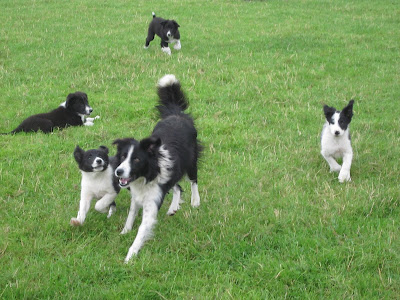A border collie can truly enrich your life if you are willing to invest the time and energy required.
If you don't get out alot and have time constraint's then a border collie may not be the match for you. If you treat the dog well they will become excellent companion dogs. They bond strongly with their owners. They will be your best friend loyal and by your side. They thrive when they have a job and space to run. They love their owners but can be weary of strangers.
The border collie is an extremely intelligent dog. The border collie has beauty and brains. They have a keen sense of their surroundings.Their high intelligence means that they can be trained to a high degree but they can also push the boundaries. They have agility, focus and stamina
They are the Olympic athlete of the dog world.
They are too intelligent to lie around and do nothing all day.If you are considering having a border collie in your life you must be willing to give them alot of mental stimulation. They have boundless amounts of energy so be willing to exercise your collie daily.

The Border Collie has an amazing herding instinct. This instinct has been bred into them. Many herding dogs drive the livestock away from the farmer but the border collie has the skill of circling the sheep and bringing them back to the farmer. They can mostly do their job without force. The border collie uses his eye stare on the job by giving a threatening stare to intimidate the stock into submission along with a crouching stance. If the sheep is more stubborn the dog may bark nip or bite to get the job done if need be. They have an amazing skill of anticipation. They are great at anticipating what the stock will do. They can move at great speed. They can gather, drive and keep the stock in one place. The border collie is said to have an eye that can hypnotise cattle. They crouch down and intensely stare at the cattle. The intimidating stare with the intimidating crouching snakelike movements garner the cattle into submission allowing the dog to herd the cattle. A working dog can do the work of three humans. They are known to work with sheep, cattle, poultry,pigs,ostriches and clear runways and golf courses of birds.

If a border collie is in a home that doesn't provide them with enough mental stimulation and exercise they can develop neurotic behaviours. If bored and neglected they may chew furniture , dig holes etc. Any bad habits like chasing cars, children and cats come from their herding instincts. These habits are due to the fact that they are motion sensitive. With training and patience these problem's can be solved.
If you want to win competitions in dog agility, dog Frisbee, flyball, tracking and obedience then you have a good chance with a border collie. They also are a master of dance when trained dog dancing.
An awe inspiring experience is to watch a border collie at work. They excel in sheep dog trials. They can work form voice command or whistle.
A border collie called chaser has a vocabulary of 1022 words.
Their country of origin is Scotland and England.
Tiger Woods has a border collie called Taz.
Litter size is 6 to 8 pups.
Their life span is 12 to 16 years.
Weight male 29-45 lbs female 27-42 lbs.
Height male 19-22 inches female 18-21 inches.
Great for search and rescue.
Their coat can be rough{medium to long} soft {short}coat.
They are very handsome dogs most common black and white, black and tan,blue merle, red merle, red and white.
They need an outlet for their energy.
They have been helping farmers work for hundreds of years.
Old hemp a dog born in 1893 is the ancestor of most border collies today.
They should exercise for 2 hours a day.
Nipping at ankles and heels is natural for BC training should ease it.
They require regular brushing.
Traffic is dangerous for border collies as they may try to herd.
If left alone and bored they may become depressed.
They can be moody, quirky, strong willed,inventive,manipulative.
 Do not leave your dog or puppy outside alone without a heated shelter.
Do not leave your dog or puppy outside alone without a heated shelter.






.JPG)













































